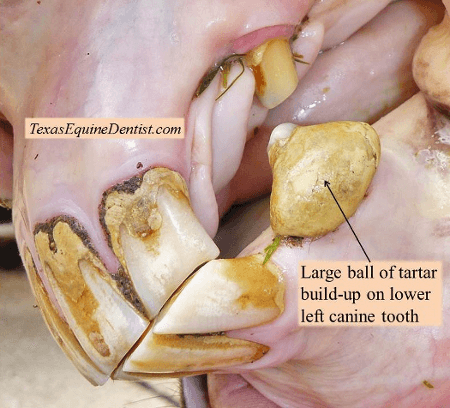Common Equine Dental Problems

As grazing animals, horses are dependent upon their teeth for chewing and grinding food for optimum nutrition. Dental problems can cause constant pain and irritation for the animal, resulting in behavioral issues and poor performance. A horse with dental problems can even be downright dangerous!
While horses can be born with or develop a variety of dental issues, regular equine dental exams by Dr. Warren will minimize or even eliminate these problems. Preventive dental care and treatment results in a happier, more willing equine companion.
Some Common Equine Dental Problems
Horse teeth wear in specific patterns throughout the animal’s life. Wear patterns can change due to variances in the diet, environmental conditions such as sandy soil, or even vices like cribbing. Uneven wear of the teeth is the most common dental issue for today’s domestic horses.
Some typical tooth wear issues that may impact your horse include the following conditions:
Sharp Enamel Points

Sharp enamel points develop on the cheek side of the top teeth and the tongue side of the bottom teeth. These points impede chewing and cause painful ulcers and lacerations in the cheek and tongue. It is by far the most common dental problem in horses of all ages.

Luckily, sharp enamel points are easily removed by the dental procedure and most ulcers will heal in 5-7 days.
Since horse's teeth continue to erupt at a rate of 1/8th inch per year, sharp enamel points will return. This necessitates yearly dental exams to prevent ulcers from recurring.
Step Mouth

Step mouth occurs when one cheek tooth is longer than the others. This often happens when the opposite tooth has been broken or is missing and wear to the grinding surface becomes uneven.
Wave Mouth
Wave mouth is common in horses 12 years and older that have not had adequate dental care.

In this photo, the teeth in the middle of the upper row are shorter than the others, creating a wave-like pattern. This leads to excessive uneven wear as well as periodontal disease and tooth loss.
Shear Mouth

Shear mouth occurs when the grinding surface of the cheek teeth become severely sloped, with the inner edge of the teeth much higher or lower than the outer edge. This preventable condition seriously impedes chewing and digestion, resulting in weight loss and malnutrition.
Wolf Teeth

Wolf teeth are small vestigial cheek teeth, most often on the upper jaw, appearing in some horses. Wolf teeth can interfere with the bit and cause pain. They are usually removed without subsequent problems.
Incisors

Incisor abnormalities come in various forms. They can occur due to fractured or missing teeth, malocclusions, retained baby teeth, and conformation issues such as parrot mouth.
Hooks

Hooks are formed when the front border of the upper 1st cheek teeth are further forward than the lower 1st cheek teeth. Hooks can become so long that they cut into the gum of the lower jaw.
Tartar

Tartar builds up on the lower canine teeth and sometimes on the incisors. It is normally a yellow-brown chalky deposit that develops on the teeth that are in the area where the salivary ducts open into the mouth.
Tartar is found more often in horses fed a high sugar content feed. It can cause gingivitis and, in extreme cases, tooth decay.
Retained Baby Teeth

Horses shed 24 baby teeth between the ages of 3 and 5 years of age. If baby teeth do not shed properly they can lead to a number of issues such as difficulty chewing, resisting the bit, and improper eruption of adult teeth.

This is a photo of the above retained baby tooth after it was removed. The dark staining and buildup of feed particles indicates it had been loose for quite some time.
